|
https://ift.tt/2NSehRm
Stop Gambling with Your Marketing and Go Pro with Tips from Ten Pubcon Pro Speakers https://ift.tt/2NOIUHd
In the fast paced world of search and digital marketing, what separates amateurs from professionals often comes down one simple distinction: marketing as a gamble or marketing as a planned, measured and iteratively optimized discipline. There are far too many marketing campaigns being implemented simply because “that’s how we’ve always done it”, as a reaction to the competition and as a limitation of the in-house team tasked with execution. Professional marketers go beyond wishful thinking and hopes of “better luck next time”. So, what does it mean to be a “professional”? Being a professional in any industry represents a combination of characteristics including:
Marketing professionals represent these things and more:
If you want more marketing success, it takes a shift in perspective, an effort to expand your knowledge and awareness of what’s possible. There are few “sure things” in marketing, but one thing you can count on is the value of the expertise and advice from the group of 10 expert marketers contributing to the Marketers Go Pro ebook we developed for the Pubcon Pro conference in Las Vegas happening in a few weeks. We polled the keynote and main stage speakers for their best advice based on the presentations they will be giving at the conference. I’m one of those main stage speakers, so I contributed as well. Here’s a list of the marketing experts who contributed and a taste of the insights you’ll find inside the ebook:
To see the full text of our experts’ advice, check out the full ebook below. You’ll also find the details of when, where and what their keynote and main stage presentations will be about. Besides me, TopRank Marketing will have several team members attending and liveblogging at the Pubcon Pro conference including our agency social content manager, Lane Ellis and senior account manager, Tiffani Allen. You can follow them at @lanerellis and @tiffani_allen as well as our agency tweets during the event at @toprank. We hope to see you there!
© Online Marketing Blog - TopRank®, 2018. | Stop Gambling with Your Marketing and Go Pro with Tips from Ten Pubcon Pro Speakers | https://ift.tt/2wiHYzh The post Stop Gambling with Your Marketing and Go Pro with Tips from Ten Pubcon Pro Speakers appeared first on Online Marketing Blog - TopRank®. Mobile Marketing via Hubspot https://ift.tt/2wiHYzh September 28, 2018 at 04:31PM
0 Comments
Disney Revamps All Its Advertising Businesses, Embracing TV, Sports, News https://ift.tt/2QfxGs8 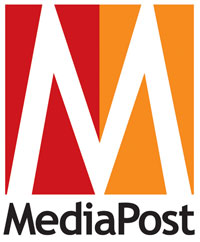 Walt Disney is revamping its entire advertising sales activities for a new integrated organization. Under its new advertising group -- recently formed under Rita Ferro, president of Disney Advertising Sales -- the restructure will affect the entire company’s entertainment, sports, news and kids linear and digital TV and radio businesses. That includes ESPN and Disney/ABC properties, as well Disney's mobile, social and digital portfolio and national ad sales for ABC’s eight owned local TV stations. The integrated ad sales organization will be structured into three areas: sales, client and brand solutions, and revenue and operations. The sales group will be led by six senior vice presidents, advertising sales, reporting to Ferro: Patricia Betron, Marco Forte, Flora McKiernan, Andrew Messina, Wendell Scott, and Jeremiah Tachna. They will be responsible for managing account teams under specific industries, as well as managing dedicated agency teams. The client/brand solutions team will be responsible for providing clients insights to help grow their businesses, as well as creative solutions for storytelling capabilities for marketers. advertisement advertisement Four teams within the group will report to Ferro. Leading each team will be: Wanda Young, senior vice president, client solutions of insights/creative; Sean Hanrahan, senior vice president, sports brand solutions; Jerry Daniello, senior vice president, entertainment brand solutions; and Zach Chapman, vice president, International Alliances. For revenue and operations, Laura Nathanson, will lead this group as executive vice president-revenue and operations, responsible for optimizing and managing business opportunities. Key executives in this unit will include Doug Hochstadt, Travis Howe, James Minnich, Laura Nelson and James Vanderhoef. Additionally, Josh Mattison, vice president, business operations, will report to Ferro. Disney Advertising Sales exists under Disney’s new direct-to-consumer and international business. This unit is responsible for direct-to-consumer businesses -- including the ESPN+ premium sports streaming service; an upcoming Disney-branded direct-to-consumer streaming service; and the Disney’s ownership stake in Hulu. Mobile Marketing via MediaPost.com: mobile https://ift.tt/2oB2PsH September 28, 2018 at 02:56PM
https://ift.tt/2R2pFId
Pilot Flying J Jumps On College Football Bandwagon https://ift.tt/2xX2fLn
Themed “Welcome To,” it includes creative running across TV, digital platforms and billboards that will continue to roll out in an expanded capacity through 2019. The 360-degree efforts include exclusive myPilot app promotions and partnerships with popular ESPN/SEC personalities Paul Finebaum and Laura Rutledge as well as brands ORCA, Johnsonville and Dr Pepper, Subway and Denny’s. The effort “elevates” the second year of the four-year ESPN and SEC networks sponsorship, said Whitney Haslam Johnson, chief experience officer for Pilot Flying J. advertisement advertisement The TV spot features Carol, an enthusiastic staffer who showcases what Pilot Flying J has to offer to every guest that comes through the door, including college football fans. The spot will air on SEC Network, ABC and ESPNproperties and run digitally on ESPN.com, SECNetwork.comand the ESPN app. The football-themed campaign will be integrated into a larger brand campaign. In Pilot Flying J’s home city of Knoxville, Tenn., “Welcome To” creative is being tested on billboards. Fans can pick up ORCA drinkware and coolers in travel centers across the country from Nov. 1 (or until supplies last). In SEC-specific markets, ORCA products will be regionally branded, featuring emblazoned logos of participating SEC schools. Throughout the college football season, Pilot Flying J and ORCA will also be partnering to deliver exclusive giveaway opportunities like the “ultimate tailgate package,” a weekly giveaway at all SEC Nation stops. Fans looking to upgrade their gameday gear can buy and scan a 20 oz. Dr Pepper at participating Pilot Flying J locations to receive 30% off college gameday gear. The promotion runs from through Dec. 6. The sponsorship provides exposure for Pilot Flying J on SEC Network programming and within the SEC footprint through SEC Nation, the network’s traveling football pregame show. The company will also be the presenting sponsor for three of SEC Nation’s regular-season broadcasts. The brand will bring its mobile “Fueling All Fans Experience” unit to various college campuses alongside SEC Nation, which will offer two of Pilot Flying J’s in-store food items right outside the stadium: cold brew coffee and Johnsonville Cheddar Beer Brats. Fans can also enter on-site to win the weekly “ultimate tailgate package” giveaway from ORCA and Pilot Flying J. VIDEOMobile Marketing via MediaPost.com: mobile https://ift.tt/2oB2PsH September 28, 2018 at 02:56PM Affiliate New Customer Revenue Rose 45% In Q2 2018 https://ift.tt/2xSQ1mY  Easter, Mother’s Day, Memorial Day and back-to-school all provide opportunities to grow affiliate marketing programs, but opportunities for marketers and brands increase heading into the end-of-year holiday season. Acceleration Partners, a global performance marketing agency, released the results of an in-depth study on its e-commerce and retailers' affiliate programs, which show growth. “Marketers are moving toward cost per acquisition and affiliate channels,” Bob Glazer, founder of global performance marketing agency Acceleration Partners. “They want to pay for the outcome -- pay for things when they generate results, rather than the input.” The average commission rate across affiliate partners rose by 18% during the second quarter of 2018 compared with one year ago. The percentage of affiliate program revenue from new customers in the second quarter of 2018 was 45%, up from 38% in second-quarter 2017. Overall, revenue across the affiliate channel revenue rose 23% year-over-year (YoY), while mobile took 15%. advertisement advertisement Retailers saw clicks driven by affiliate partners rising 35% YoY in the second quarter of 2018, with Memorial Day weekend seeing clicks up 48% YoY. The Memorial Day weekend saw the strongest YoY growth, with revenue up 43%. Acceleration Partners, which manages campaigns for Adidas, Target and Uber, examined data from more than 13,000 active retailer/affiliate client partnerships between the second quarter of 2017 and the second quarter of 2018. Retailers’ click active affiliate partnerships increased by 8% YoY, while sale active partnerships rose 16% YoY. Content publishers continue to be valuable partners. In the second quarter, this partner segment rose 75% YoY. Mass Media publishers such as BuzzFeed, Business Insider, Forbes and others drove notable growth in revenue -- about 38% YoY. And deal affiliates saw strong YoY click-rate growth, up 66% YoY. Mobile Marketing via MediaPost.com: mobile https://ift.tt/2oB2PsH September 28, 2018 at 02:56PM What Google Investments Tell Marketers About Its Search Roadmap https://ift.tt/2OmHCm0  If marketers want to map the future of search, all they need to do is track the number of times company executives mention a technology, especially during earnings calls, words in patents, and hush-hush investments such as Google’s in Gradient Ventures, a company that invests in early stage AI startups, and Google Assistant investment program. Analyze, also, the amount companies spend in research and development. CB Insights maps recent investments in terms of absolute dollars and a percentage of sales for some of the top companies. Amazon leads with $22.6 billion in 2017, followed by Google at $16.6 billion, Microsoft at $13 billion, Apple at $11.6 billion and Facebook at $7.8 billion. In terms of percentage of sales, Facebook leads with 19.1%, Google at 15%, Microsoft at 14.5%, Amazon at 12.7%, and Apple at 5.1%, according to CB Insights. advertisement advertisement Google may have made a major acquisition when it acquired DeepMind for $600 million in 2014, but in 2018 it also acquired Halli Labs, AIMatter, and Banter, which all focus on AI. Several recent patents also suggest Google prioritizes deep learning, rather than machine learning. Deep learning doesn’t require adjustments from engineers to make predictions. CB Insights notes that although AI has been a key focus for more than a year, the mention of AI and machine learning by Google executives on company earning’s calls reaches a new peak in the second quarter of 2018. Overall, CB Insights estimates about 86% of revenue comes from advertising, but rising ad costs, increased regulations, heightened competition, and a shift to mobile and voice are threatening Google’s business in search and advertising. One of the biggest threats to Google, Amazon’s large percentage of product search market share. Amazon dominates product searches, according to Survata’s annual survey, though Google re-captured some of that lost share. Product searches still make up roughly 60% of Google’s total ad click share. Data from eMarketer shows Amazon demonstrating growth. eMarketer forecasts a 3% gain in the ad market for Amazon in the next two years. Another threat, Google’s traffic acquisition costs continue to increase. It has for several quarters. It is the largest expense for the company. TAC is expected to rise with the shift to mobile and regulations around data privacy. Pressure from Amazon and Apple also continue to put pressure on the company. And still, Google trails Amazon and Microsoft in terms of the market share owned by these companies. In 2018, Google took about $1.6 billion, about 8% of the cloud market. Mobile Marketing via MediaPost.com: mobile https://ift.tt/2oB2PsH September 28, 2018 at 01:49PM Three Years Out: That's When Shoppers Can Expect To See Great, AI-Driven Service https://ift.tt/2NObzMv  Retailers are embracing a new model, using AI, breaking down internal channel silos and fielding single-order management systems to deliver a superior customer experience. At least that’s the dream. In reality, almost half are plagued by budget constraints and/or disparate systems, according to the 2018 Customer Experience/Unified Commerce Survey by BRP. And this apparently is having an impact. For instance, 48% plan to deploy AI to fuel their customer service within three years, but only 7% are doing so now. In addition, 31% plan to use augmented reality within three years, and 21% virtual reality — again, within three years. And email? The study shows that 81% are using personal email as a means of customer interaction with the brand. But only 36% say it is working well, and 45% feel they need improvement. Social media is utilized by 94%, with 36% saying it works well and 48% saying they need improvement. And 81% are using call centers, with 36% saying they need improvement. advertisement advertisement The study notes that email and text messaging have “grown exponentially over the past few years.” It adds that “as the majority of consumers have mobile phones where they can easily and quickly check email and texts, this is definitely an area of opportunity.” Speaking of mobile, 93% are planning to have a mobile/tablet app for associates within three years, up from 81% in the 2017 survey. Another opportunity is in the scrapping of paper. Of the retailers polled, 17% are offering the option to email customer receipts as an incentive to encourage identification. Of course, email ranks far below more personalized service as an incentive — 37% are offering it. In addition, 30% are promoting product incentives, 27% are promoting specialized offers and 27% are promoting product information. And 37% have no incentives at all. Many retailers are also improving their cross-channel capabilities. For instance, 66% have implemented consistent product assortment across channels, but 38% say they need improvement. And 65% are offering consistent pricing/promotion across channels, with 34% saying it’s not totally successful. But only 7% offered shared cart across channels service, and all of them see room for improvement. Another 52% plan to try it within three years. One more area needing upgrading is returns visible and accepted across channels — 41% plan to implement it, but have not yet. What are their customer experience priorities? They are:
Their biggest challenges in achieving unified commerce?
BRP surveyed over 500 North American retailers. Mobile Marketing via MediaPost.com: mobile https://ift.tt/2oB2PsH September 28, 2018 at 01:14PM Did Video Eat Programmatic's Lunch? Is GDPR To Blame? https://ift.tt/2xL64nX  As we prepare for the final day of the third quarter, the figures are in for video advertising during the second quarter, and it would appear to have been a very good quarter -- quite possibly at the expense of programmatic display. According to figures from Comcast's FreeWheel, premium video ad viewing was up more than a fifth in the second quarter, compared to the same period the year before. Interestingly, this contrasts with programmatic. The researchers behind the figures point to figures that suggest programmatic display dropped by 25% to 40% across Europe in the quarter as a result of concerns surrounding GDPR. indeed, direct deals are on the up in video by 42%, to now account for nearly nine in ten spots sold, at 88%. It's pretty easy to see why FreeWheel is making the connection between video going up and GDPR seeing programmatic going down when one considers that the vast majority of these premium video spots are being bought directly. As one can imagine, premium video ad viewing saw huge leaps on set-top boxes through OTT streamers and on mobile devices which grew, respectively, by 21%, 41% and 46% compared to the same period last year. The big elephant in the room here is, of course, the football World Cup, the researchers point out. It's worth pointing out that the month-long competition was only halfway through by the end of June -- although, having said that, the first half of the competition would have seen more games, and so advertising opportunities, compared to the latter half. So it's almost certain that the world's biggest football tournament, that is watched religiously across Europe, would have led to a swell in viewing figures and opportunities to reach football fans through premium video. In fact, there's an extra sign that World Cup was at play because nearly a third of premium video ads were viewed on a large screen -- the preferred choice of a sports fan streaming or catching up with the day's big game. It will be interesting to see where the current and last quarter of the year takes us. By autumn and then holiday shopping season, one can presume that programmatic will have recovered from any GDPR jitters and the quadrennial boost from the World Cup will have been removed. The truly interesting part for all marketers? When it comes to premium, there is a growing trend to go direct. We can see this in display through the country's leading news organisations banding together to allow direct sales across multiple well-known titles. Despite Integral Ad Science figures out this week showing low fraud levels and high viewability figures for direct and programmatic campaigns, there seems to be a weight of momentum connecting premium publishers with premium advertisers directly. Mobile Marketing via MediaPost.com: mobile https://ift.tt/2oB2PsH September 28, 2018 at 09:42AM Banking The Future On Short-Form Video Ventures https://ift.tt/2xNqvQZ  Santa Barbara, Calif. -- Enjoying bite-size video content while waiting on line at a bank, supermarket or doctor’s office is what future TV viewers, especially young millennials desire. But will they still want that when they are older? Veteran movie/TV and technology executives -- Jeffrey Katzenberg, chairman-founder of NewTV (working title) and Meg Whitman, chief executive officer of NewTV -- say millennials spend many hours a day watching videos this way, that is, while they are not using social media, texting or playing online games. But that viewing seems to be in small increments, which makes sense when it comes to mobile devices. How much bite? Around 10 minutes. Apparently, that’s all you need, says NewTV -- a mobile-first, premium video service. Can that be a business? Katzenberg, speaking at the AT&T Relevance Conference here, says many viewers are already watching regular ad-supported TV this way. For years, TV producers have worked in nine-to-10 minute continuous programming content increments on TV shows -- you know, the stuff between commercials. They actually constitute short "episodes." Will millennials who don’t have enough time to watch an entire TV episode in one sitting take in short premium TV segments on the go? In the future, one might call this “micro” binging. This could be a big ask -- even for millennials that watch traditional TV. Perhaps on mobile devices, TV viewers -- including young viewers -- perceive content differently than on a big TV screen. Big movie/TV studios are betting on the future. Katzenberg has financially backing from virtually all major traditional TV/movie studios, a massive $1 billion. That says something; they have a lot to gain. Movie studios see mobile video content and distribution as continuing to evolve and disrupt traditional media -- including the big business of premium TV and movie content. There is some science at work here. But also a lot of guess work. At its creation, Facebook probably didn’t have much science to back up a social network. But it had a hunch. Big media needs more crazy hunches. Mobile Marketing via MediaPost.com: mobile https://ift.tt/2oB2PsH September 28, 2018 at 08:17AM 5 Reasons To Start Taking CTV Seriously https://ift.tt/2Oi4bsd 
By this time next year, the 25 million households across the country that own connected TVs (CTV) will think nothing of shampoo ads gracing their screens as they settle down in front of "American Horror Story" Season Nine. The idea of CTV advertising may have recently caused ripples in the media world and beyond, but rumours that Amazon is on the cusp of serving ads and Netflix is close behind are rapidly gaining momentum. CTVs -- meaning anything ranging from smart TVs to streaming devices to game consoles -- offer a kind of advertising that falls somewhere between traditional TV commercials and digital ads. Guaranteed to be full resolution, I have recently seen them called "lean-back branding experiences," which certainly hints at their vast cinematic potential. And with promos for Netflix series currently being served between episodes, here is why brands in the UK should now be preparing themselves for this genuine opportunity:
With ticks in the boxes for viewability, recall and targeting, the opportunity is clear. But there are still a few hurdles to overcome before CTV becomes stratospheric. Quality inventory is still relatively limited and fragmented, with many ads being privately sold and not yet served across the major broadcasters. And the age-old issue of measurement is also a stumbling block. The industry is currently undecided on how to best track activity, which means it is currently difficult to justify investment decisions. However, Nielsen and SpotX have been undertaking some interesting trials in the US over the last couple of months. So brands should be poised and ready to embrace the CTV advertising opportunity. The medium will grow rapidly as soon as the big players like Netflix and Amazon Prime push the button, which is surely only a matter of time. advertisement advertisement Mobile Marketing via MediaPost.com: mobile https://ift.tt/2oB2PsH September 28, 2018 at 06:09AM
https://ift.tt/2xIIDvr
Digital Marketing News: Adobe’s $4.75B Marketo Buy, Google’s 20th Anniversary Neural Matching, & Facebook Lets Pages Join Groups https://ift.tt/2xXDnmP
Adobe’s $4.75 Billion Purchase of Marketo Will Boost Its Ability to Compete With Salesforce Google Begins Using Neural Matching to Understand Synonyms, Impacting 30% of Queries Facebook Will Now Allow Pages to Join Facebook Groups Report: Digital now makes up 51% of US ad spending 5 Key Benefits of Word of Mouth [Infographic] Most B2B Marketers Report Positive ROI… If They Know What It Is.
Instagram co-founders resign in latest Facebook executive exit What’s driving B2B buyers to e-commerce Google’s Data Studio is now generally available How Marketers Can Be Strategic Influencers, and Why Their Input Is Key for Companies [Infographic] ON THE LIGHTER SIDE:
A lighthearted look at 360-Degree Customer View by Marketoonist Tom Fishburne — Marketoonist Here are all of Google’s 20th anniversary Easter eggs — TechCrunch TOPRANK MARKETING & CLIENTS IN THE NEWS:
What are some of your top content marketing news items this week? Thanks for joining us, and we hope you’ll check in again next week for a new selection of the most relevant digital marketing industry news, and in the meantime you can follow us at @toprank on Twitter for even more timely daily news. Also, don’t miss the full video summary on our TopRank Marketing TV YouTube Channel.
© Online Marketing Blog - TopRank®, 2018. | Digital Marketing News: Adobe’s $4.75B Marketo Buy, Google’s 20th Anniversary Neural Matching, & Facebook Lets Pages Join Groups | https://ift.tt/2wiHYzh The post Digital Marketing News: Adobe’s $4.75B Marketo Buy, Google’s 20th Anniversary Neural Matching, & Facebook Lets Pages Join Groups appeared first on Online Marketing Blog - TopRank®. Mobile Marketing via Hubspot https://ift.tt/2wiHYzh September 28, 2018 at 05:44AM |
CategoriesArchives
April 2023
|

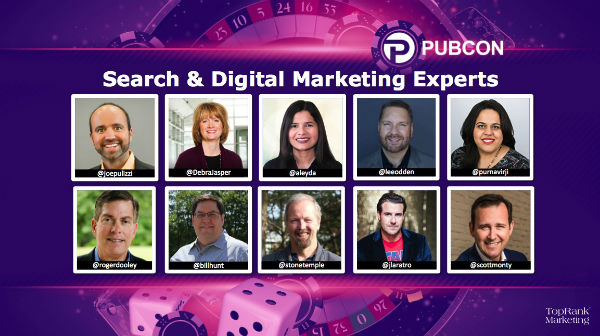











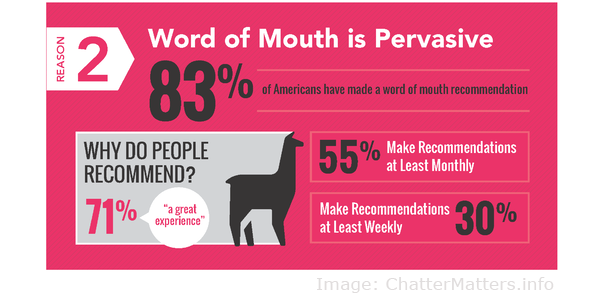
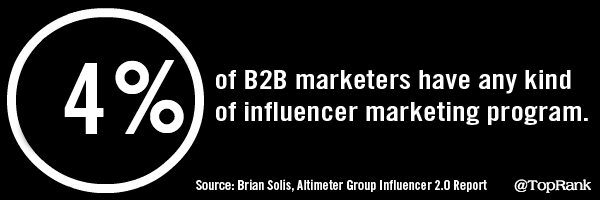
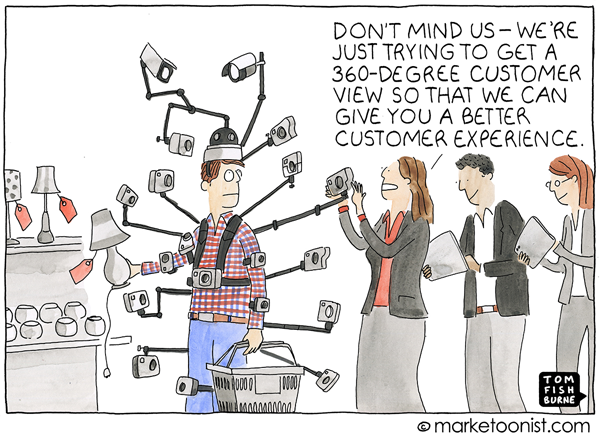
 RSS Feed
RSS Feed
